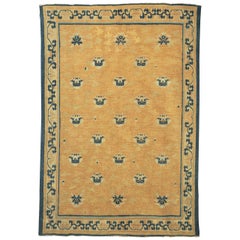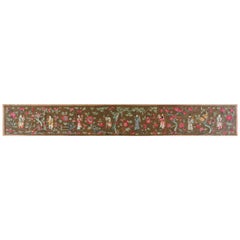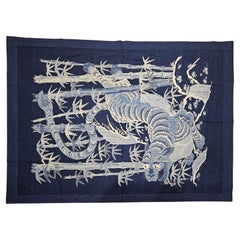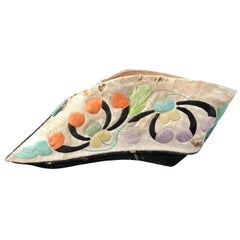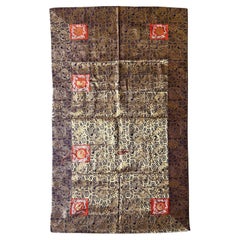East Asian Textiles
to
52
291
85
399
27
1
24
11
1
1
1
16
193
190
28
113
47
3
15
1
14
9
2
1
2
1
416
268
83
59
52
1,327
462
443
432
427
427
423
427
3
1
1
Place of Origin: East Asian
Early Chinese Ningxia Rug with Lotus Flowers
Located in Milan, IT
A rare and beautiful early Chinese carpet characterized by an infinite repeat of parallel and offset rows of blue and ivory lotus blossoms, symbols of purity, on a two-tone yellow ba...
Category
Early 17th Century Ming Antique East Asian Textiles
Materials
Wool
Modernist Geometric Chinese Rug, 1930's
Located in Milan, IT
A rare and unusual carpet woven in two colors with an all-over pattern of square devices. Although it was originally sourced in China, carpets of this type were influenced by the Eur...
Category
1930s Art Deco Vintage East Asian Textiles
Materials
Wool
Late 19th Century Chinese Silk & Metal Embroidery ( 1' 9'' x 12' 9''-53 x 387 )
Located in New York, NY
Late 19th Century Chinese Silk & Metal Embroidery
1' 9'' x 12' 9''-53 x 387
Category
1890s Qing Antique East Asian Textiles
Materials
Wool
Vintage Japanese Hand Crafted Indigo Textile of a Tiger in a Bamboo Forest
Located in Barrington, IL
A rare and visually powerful vintage Japanese hand-crafted indigo textile, featuring a dynamic depiction of a tiger amidst a bamboo forest. This traditional design draws on deep symbolism in Japanese folklore, where the tiger is revered as a protective guardian spirit—an embodiment of strength, courage, and mystical power.
The tiger was believed to command the forest and mountains, its thunderous roar capable of warding off evil spirits and demons. In classical writings, it was even titled the “King of the Mountain,” said to carry a hidden treasury of blessings. Rendered in indigo-dyed natural fibers, the hand-executed design marries folklore and craftsmanship in a highly decorative and culturally resonant textile.
Ideal for use as wall art, a tapestry, or a statement piece in globally inspired interiors, this textile brings a sense of myth, nature, and Japanese heritage to refined contemporary or traditional spaces. A unique collector’s piece for those drawn to symbolic art and hand-crafted textiles.
Dimensions: 47” x 64”
Date of Manufacture: Mid 20th Century
Place of Origin: Japan
Material: Cotton Indigo Textile
Condition: Excellent
The Persian Knot Gallery, SKU 2049
vintage Japanese indigo textile...
Category
Mid-20th Century East Asian Textiles
Materials
Cotton
Woman's Footwear with Bandaged Feet China Circa 1900
Located in Beuzevillette, FR
Woman's shoe with bandaged feet, in embroidered satin.
The custom of bandaged feet is said to have appeared in China in the 10th century during the Tang Dynasty, when the emperor as...
Category
1880s Chinoiserie Antique East Asian Textiles
Materials
Satin
Magnificent Antique Japanese Woven Brocade Kesa Monk's Robe Meiji Period
Located in Atlanta, GA
A stunning Japanese Kesa (Monk's Vestment) made from thirteen columns of patchworks of shimmering woven brocades with luxuriant golden threads. Dated to late 19th century of Meiji Period, the elaborate woven motifs on this kesa feature repetitive roundels dragon and phoenix intermixed with peonies and chrysanthemum blossoms. Two shades of contrasting gold threads were used on a striking purplish-blue background, with a dark metallic thread for the outer border and a brighter thread for the main body. The brilliantly woven fabric was possibly recycled from Noh costumes...
Category
Late 19th Century Meiji Antique East Asian Textiles
Materials
Brocade, Silk
Fukurou(fuyu) by Blue Tip Atelier
Located in Sammu-shi, Chiba
Title : Fukurou (fuyu)
Japan / 2024s
Size : h 490 × w 1720 mm
An owl flapping through the winter trees is expressed through hand-painted, dyeing, quilting, and embroidery.
The mater...
Category
2010s Modern East Asian Textiles
Materials
Linen
Big Tree by Blue Tip Atelier
Located in Sammu-shi, Chiba
Title : Big Tree
Japan / 2024s
Size : w 820 × h 1950 mm
The large tree is expressed through dyeing, quilting and embroidery.
The material is fine Croatian Linen.
Hand quilted with c...
Category
2010s Modern East Asian Textiles
Materials
Linen
Vintage Japanese Indigo Folk Kamon Textile
Located in Chicago, IL
Dating to the mid-20th century, this vintage Japanese textile is a folk example of traditional stencil dyed fabric, known as katazome. Richly...
Category
Mid-20th Century East Asian Textiles
Materials
Cotton
Chinese Silk Embroidery From Mid 19th Century ( 5" x 3' - 13 x 92 cm )
Located in New York, NY
Chinese Silk Embroidery From Mid 19th Century ( 5" x 3' - 13 x 92 cm )
Category
1850s Antique East Asian Textiles
Materials
Silk
Antique Samarkand Carpet, c. 1920
Located in Chicago, IL
This masterfully knotted early 20th century samarkand carpet depicts a floral pattern at its center, framed by an ornate geometric border. Sometimes referred to as Khotan carpets, sa...
Category
Early 20th Century Khotan East Asian Textiles
Materials
Wool
PAIR OF 19TH CENTURY CHINESE DRAGON FOO DOG GOLD SILVER STITCH SILK EMBROIDERIEs
Located in West Sussex, Pulborough
Royal House Antiques
Royal House Antiques is delighted to offer for sale this stunning pair of original circa 1880 Chinese gold and silver threaded tapestry on silk depicting Chines...
Category
1880s Chinoiserie Antique East Asian Textiles
Materials
Silk
Antique Chinese Art Deco Oriental Rug, in Small Size with Vase and Flower Motifs
Located in New York, NY
An antique Chinese Art Deco oriental rug, size 4'0 x 2'0, circa 1920. This lovely hand-knotted antique carpet features various traditional Chine...
Category
1920s Vintage East Asian Textiles
Materials
Wool
$1,195 Sale Price
20% Off
Antique Chinese Textile 0' 5'' x 0' 22''
Located in New York, NY
Antique Chinese Textile, Size: 0' 5'' x 0' 22''
Category
Early 1900s Antique East Asian Textiles
Materials
Metal
Chinese Nichols Round Oriental Wool Rug, C1940
By Nichols
Located in Big Flats, NY
A Chinese Nichols oriental rug offers wool construction in circular form with central floral medallion on red ground, C1940
Measures - 55''H x 55'...
Category
Mid-20th Century East Asian Textiles
Materials
Wool
$440 Sale Price
20% Off
Framed Tibetan Woven Silk Kesi Panel of Kirtimukha
Located in Atlanta, GA
A woven silk Kesi panel depicts Kirtimukha from Tibet circa the second half of 20th century. Beautifully woven from short weft silk with superb coloring and ...
Category
20th Century Tibetan East Asian Textiles
Materials
Silk
ViNTAGE CHINESE SILK EMBROIDERED TAPESTRY DEPICTING PANDAS HAVING FUN IN FOREST
Located in West Sussex, Pulborough
Royal House Antiques
Royal House Antiques is delighted to offer for sale this lovely super decorative vintage Chinese Silk Tapestry Depicting Pandas having fun in the forest
A very...
Category
20th Century Chinese Export East Asian Textiles
Materials
Silk
Antique Chinese Embroidery Brocade Collar Qing Dynasty Cat Asian Arts Framed
Located in Roslyn, NY
An antique Chinese embroidery Brocade Collar Qing dynasty cat and floral Asian arts beautifully framed.
Category
19th Century Antique East Asian Textiles
Materials
Fabric
1930s Art Deco Chinese Rug with Abstract Design
Located in Milan, IT
This rare and unusual carpet, which is perhaps more reminiscent of a contemporary painting than a weaving, is decorated with a 'salt and pepper' effect through the miscellany of red ...
Category
1930s Art Deco Vintage East Asian Textiles
Materials
Wool
Tibetan Saddle Carpet with Floral Medallions, c. 1900
Located in Chicago, IL
This unusually-shaped carpet is known as a "makden" and was originally used by a nomadic traveler as an artful covering for his horse. Placed between the saddle and the horse, the makden cushioned the rigid saddle and kept the horse warm in cold climates. Most under-saddle carpets...
Category
Late 19th Century Tibetan Antique East Asian Textiles
Materials
Fabric, Wool
Antique Framed Japanese Silk Kesa Monk's Robe Edo Period
Located in Atlanta, GA
A Japanese Kesa (Monk's Vestment) made from thirteen columns of patchworks of brocades set within a border of the same material. The brocade was woven from a subtle color palette of ...
Category
19th Century Edo Antique East Asian Textiles
Materials
Brocade, Silk
Framed Antique Chinese Qing Dynasty Embroidery 24LP110
Located in Pomona, CA
Originally purchased from Hong Kong, this Chinese antique embroidery presented in a museum quality. This textile was a roundel design likely from the center front of a noble woman's...
Category
Early 20th Century Chinese Export East Asian Textiles
Materials
Silk
$712 Sale Price
25% Off
Framed Antique Chinese Embroidery Panel Qing Dynasty Provenance
Located in Atlanta, GA
An antique Chinese embroidery panel, originally the sleeve band of a robe from Qing Dynasty, circa 19th century. Nicely presented as a...
Category
Mid-19th Century Chinese Export Antique East Asian Textiles
Materials
Silk, Wood
Japanese Antique Fukusa Textile Art Meiji Period
Located in Atlanta, GA
A Japanese silk Fukusa panel circa late 19th-early 20th century of Meiji Period. The front was beautifully decorated with Yuzen-zome, a labor intensive resist-dye technique invested ...
Category
Early 20th Century Japonisme East Asian Textiles
Materials
Silk, Beads
Tibetan Saddle Carpet with Floral Medallion, c. 1900
Located in Chicago, IL
Known as an over-saddle carpet or "masho," this small rectangular carpet was once used by a nomadic traveler as an artful covering for his saddle. Placed...
Category
Late 19th Century Tibetan Antique East Asian Textiles
Materials
Fabric, Wool
Antique Japanese Embroidered Silk Kesa Monk's Robe Edo Period
Located in Atlanta, GA
A Japanese Kesa (Monk's Vestment) made from thirteen columns of patchworks of fine shimmering silk fabric of a salmon orange color, the shade of which changed subtly from different a...
Category
19th Century Edo Antique East Asian Textiles
Materials
Brocade, Silk
Mountains at Dawn by Blue Tip Atelier
Located in Sammu-shi, Chiba
Title : Mountains at dawn
Japan / 2022s
Size : W 990 H 1500 mm
A work inspired by the mountains at dawn.
This quilt is made with french linen.
Hand-quilted with Japanese sashiko...
Category
2010s Modern East Asian Textiles
Materials
Linen
Fine Antique Peking Chinese Blue Open Field Rug
Located in Milan, IT
The fine carpets of Peking represent the other end of the spectrum of Chinese textile art, expressing a late Qing dynasty aesthetic that is based o...
Category
Early 20th Century Minimalist East Asian Textiles
Materials
Wool
Tibetan Meditation Carpet with Dorje Medallion, c. 1920
Located in Chicago, IL
Beautifully knotted of vegetable-dyed wool, carpets by the nomadic peoples of Tibet, Mongolia, and northern China decorated every aspect of life with bright color and rich symbolism. Unlike those of the Chinese weaving...
Category
Early 20th Century Tibetan East Asian Textiles
Materials
Wool, Cotton
19th Century Antique Chinese Framed Groups of Textile Embroidery Pieces
Located in Pomona, CA
A group of three antique Chinese textiles embroidery arranged and professionally matted and framed. The museum quality display includes two Identical pieces symmetrically on the top ...
Category
19th Century Chinese Export Antique East Asian Textiles
Materials
Textile, Silk
$1,875 Sale Price
25% Off
Antique Chinese Rug with Abstract Design
Located in Milan, IT
The painterly effect obtained by mixing varying proportions of ivory and indigo wool is peculiar to this family of northern Chinese weavings. As most of them were sourced directly in...
Category
Early 20th Century Chinoiserie East Asian Textiles
Materials
Wool
Framed Japanese Embroidery Textile Panel Rootsters
Located in Atlanta, GA
A matted and framed Japanese silk panel with elaborate embroidery circa late Meiji to Taisho period (1910-30s). On a bright background, two rooster...
Category
Early 20th Century Japonisme East Asian Textiles
Materials
Silk, Wood
Tibetan Saddle Carpet with Scholars' Objects, c. 1900
Located in Chicago, IL
This unusually-shaped carpet is known as a "makden" and was originally used by a nomadic traveler as an artful covering for his horse. Placed between the saddle and the horse, the makden cushioned the rigid saddle and kept the horse warm in cold climates. Most under-saddle carpets include two to four holes near the center, through which the girth straps of the saddle were threaded.
Dated to the late 19th century, this Tibetan saddle carpet...
Category
Late 19th Century Tibetan Antique East Asian Textiles
Materials
Fabric, Wool
Early 20th Century Chinese Pao-Tao Carpet, Blue with Geometric Design
Located in Firenze, IT
A Taoist lives life according to nature, trying to keep healthy from the psychophysical point of view, maintaining a deep contact with his spirituality, protecting the surrounding environment and living life with serene acceptance.
This rare carpet is an expression of this philosophy, which is read through the perfect balance of its geometric shapes. In fact, many of the recurring symbols in Buddhist iconography are represented, such as the infinite knot...
Category
1920s Vintage East Asian Textiles
Materials
Wool
Framed Japanese Relief Embroidery Textile Art of Dragon
Located in Atlanta, GA
A beautiful Japanese textile art panel with an embroidered dragon on a swirling cloud background, nicely framed with a linen matt in an antique-fi...
Category
1890s Japonisme Antique East Asian Textiles
Materials
Silk, Wood
Pair of Chinese Silk Lotus Slippers, c. 1850
Located in Chicago, IL
These dainty, pointed slippers, made of blue silk and embroidered with pink flowers, were shaped to resemble a lotus bud and enhanced the diminutive shape of bound feet. A practice that began in the Tang dynasty and reached the height of its popularity in the Qing dynasty, foot binding was a painful process intended to make a woman's feet as small as possible by restricting bone growth from an early age. The smaller the feet the more attractive and erotic they were, giving elite women a mark of elegance and a distinctive - albeit tortured - gait of small, light steps. These embroidered silk lotus slippers...
Category
Mid-19th Century Qing Antique East Asian Textiles
Materials
Cotton, Silk
Tibetan Saddle Carpet with Five Blessing Medallions, c. 1900
Located in Chicago, IL
This unusually-shaped carpet is known as a "makden" and was originally used by a nomadic traveler as an artful covering for his horse. Placed between the saddle and the horse, the makden cushioned the rigid saddle and kept the horse warm in cold climates. Most under-saddle carpets include two to four holes near the center, through which the girth straps of the saddle were threaded.
Dated to the late 19th century, this Tibetan saddle carpet...
Category
Early 20th Century Tibetan East Asian Textiles
Materials
Fabric, Wool
Exhibited Framed Chinese Qing Dynasty Embroidered Fifth Rank Badge
Located in Atlanta, GA
A fine embroidered silk civil rank badge panel (known in Chinese as Buzi) in giltwood frame originally from the Annette Martin Collection and exhibite...
Category
19th Century Qing Antique East Asian Textiles
Materials
Silk, Giltwood
Framed Japanese Futon Cover Textile Art with Resist Yuzen Dye
Located in Atlanta, GA
A large piece of framed Japanese textile circa late 19th to early 20th century, end of Meiji period. Seamed together from four vertical sectio...
Category
Early 20th Century Meiji East Asian Textiles
Materials
Cotton, Wood
Antique Khotan Rug, Deco Handmade Oriental Rug, Brown and Pink Rug
Located in Port Washington, NY
Antique Khotan rugs and carpets were produced in small villages of Eastern Turkestan, which today is a part of the Xinjiang region in Western China. This area has had a steady produc...
Category
Mid-20th Century Khotan East Asian Textiles
Materials
Wool
$5,000 Sale Price
28% Off
Antique Chinese Rug, Tan and Blue Oriental Handmade Wool Rug
Located in Port Washington, NY
China has a long tradition of carpets and the original ones, probably used as merchandise, are dated at over 2000 years ago. The art of knotting carpets was however, introduced somewhere around the 15th century in China.
The patterns on some of the older Chinese carpets...
Category
Early 20th Century Chinese Export East Asian Textiles
Materials
Wool
$2,879 Sale Price
20% Off
Japanese Monastery Robe Patchwork Kesa with inscription Edo Period
Located in Atlanta, GA
A Japanese Kesa (Monk's Vestment) made from fourteen columns of patchworks of blue brocades with sumptuous woven pattern. The elaborate motifs feature re...
Category
Early 19th Century Japonisme Antique East Asian Textiles
Materials
Brocade, Silk
Japanese Two-Piece Indigo Asa Kyogen Festival Costume Meiji Period
Located in Atlanta, GA
A two-piece Japanese festival costume based on Kyogen theater performance circa late 19th century (Meiji Period). The matching assemble consists of an oversize jacket (Suo) and a pai...
Category
Early 20th Century Meiji East Asian Textiles
Materials
Linen
Embroidered silk tapestry depicting an eagle ready to take flight
Located in Milano, IT
Japanese tapestry embroidered in polychrome silk on a light-colored fabric background, depicting an 'eagle ready to take flight from a pine branch (matsu) while watching two small bi...
Category
Late 19th Century Antique East Asian Textiles
Materials
Silk
$2,079 Sale Price
20% Off
Japanese Fireman Hood with Stencil Inscription Meiji Period
Located in Atlanta, GA
A well-preserved Japanese fireman's hood (known as hikeshi zukin in Japanese) circa 1900s, late Meiji period. Woven with thick cotton with sashiko (co...
Category
Early 1900s Japonisme Antique East Asian Textiles
Materials
Cotton
Framed Chinese Antique Brocade Dragon Panel
Located in Atlanta, GA
Antique Chinese brocade dragon panel from Imperial Qing Dynasty circa 19th century, beautifully presented with a linen mat and in a silvered wo...
Category
19th Century Chinese Export Antique East Asian Textiles
Materials
Brocade, Silk, Wood
Set of Three-Framed Antique Chinese Textiles Qing Dynasty Provenance
Located in Atlanta, GA
A set of three antique textile fragments from China, circa 19th century Qing dynasty, professionally displayed in matching giltwood frames as a triptych. Originally they were embroidered panels from semi-formal skirt...
Category
Mid-19th Century Chinese Export Antique East Asian Textiles
Materials
Silk, Giltwood
Two Framed Chinese Antique Textile Fragments Qing Dynasty Provenance
Located in Atlanta, GA
A group of two antique textile fragments from China, circa 19th century Qing dynasty, professionally preserved and displayed in giltwood frame...
Category
Mid-19th Century Chinese Export Antique East Asian Textiles
Materials
Silk, Wood
Antique Chinese Carpet
Located in Port Washington, NY
Antique Chinese carpets were woven in classical patterns, with their fret borders, shou medallions and other far-eastern motifs. These carpets,...
Category
19th Century Antique East Asian Textiles
Materials
Wool
$5,999 Sale Price
25% Off
Japanese 19th Century Kabuki Theater Gold Dance Costume Dragon And Phoenix
Located in South Burlington, VT
A large, glamorous and impressive Japanese Kabuki Theater Kimono Dance Costume with a handsome dragon and phoenix motif dating to the Meiji period, 19th century. Hand crafted of brow...
Category
19th Century Meiji Antique East Asian Textiles
Materials
Metallic Thread
Red China Embroidered Panel
Located in Alessandria, Piemonte
Red china embroidered panel, all lined for reinforcement. The embroidery is in silk.
Interesting price for closing activities.
Category
Early 20th Century Other East Asian Textiles
Materials
Silk
Late 19th Century Silk/Satin Embroidery
Located in Santa Monica, CA
Framed late 19th Century Silk/Satin Embroidery textile.
Textile itself measures 8w x 5h (inches).
Category
Late 19th Century Antique East Asian Textiles
Materials
Silk
Shabby Chic Distressed Vintage Chinese Carpet
Located in Milan, IT
Distinguished by a large central element obtained from a stylization of the 'Shou' Chinese ideogram, symbolizing infinity, this glorious carpet is further characterized by a soft tau...
Category
Early 20th Century Chinoiserie East Asian Textiles
Materials
Wool
19th Century Silk/Satin Embroidered Baby Collar
Located in Santa Monica, CA
This is a framed 19th Century Silk/Satin embroidered baby collar. Measurements reflect the framed piece.
19.25w x 15.75h x 1d
Category
19th Century Antique East Asian Textiles
Materials
Silk
19th Century Silk/Satin Embroidered Baby Collar
Located in Santa Monica, CA
This is a 19th Century Baby Collar - framed.
Framed measurements are 17.75w x 17.75h x .75d (inches)
Category
19th Century Antique East Asian Textiles
Materials
Silk
Mid 19th Century Blue and Tan Chinese Ning Hsia Mat with Lotus Blossoms
Located in San Francisco, CA
This fluffy Chinese seating square was most probably woven by ethnic Hui Muslim weavers in the area of Ningxia in northern China for a Buddhist religious institution somewhere in eit...
Category
19th Century Antique East Asian Textiles
Materials
Wool
Antique Chinese Pink Peony Carpet
Located in Chicago, IL
Taking months or even years to create, this antique area rug from the 1920s is hand-knotted of soft wool colored by natural dyes in a pastel palette of pink, tan, gold and off-white....
Category
1920s Art Deco Vintage East Asian Textiles
Materials
Wool, Cotton
Antique Chinese Silk Robe Fragment with Dragon and Dog
Located in Austin, TX
This exquisite antique Chinese silk robe fragment showcases a stunning blend of intricate artistry and cultural symbolism. The piece features...
Category
19th Century Antique East Asian Textiles
Materials
Silk
Hand embroidered linen table runner from the SoShiro Ainu collection
By SoShiro
Located in London, GB
This hand-embroidered linen table runner from SoShiro’s Ainu collection, a collaboration between award-winning artist Toru Kaizawa and Shiro Muchiri, consists of three separate pieces, so it can be buttoned up to form an extra-long runner for larger table settings.
It is made from a medium-weight linen, with a 400-gram-per-square-meter thread count, to ensure the runner remains weighted to the desired position on the table. The Blakiston’s fish owl...
Category
2010s International Style East Asian Textiles
Materials
Linen, Natural Fiber
Pair of Five Clawed Dragon Design Silk & Metal Chinese Textile
Located in Ferrara, IT
These unique and magnificent pair of textiles with their distinctive design can fascinate you for a long time. Mythical dragons depicted in these textiles consistently played a signi...
Category
19th Century Antique East Asian Textiles
Materials
Metallic Thread
Recently Viewed
View AllMore Ways To Browse
Meiji Embroidery
Japanese Wedding Kimono
Meiji Silk Embroider
Japanese Ikat
Kimono Display
Qing Dynasty Badge
Batik Java
Focal Watch Vintage
Peonies Embroidery
Sumba Textile
Turkish Shoes
Vintage Japanese Wedding Kimono
Indonesia Horse
Japanese Futon
Sumba Ikat
Vintage Embroidery Tablecloths
Ikat Textile From Sumba
Vintage Batik Indonesia
